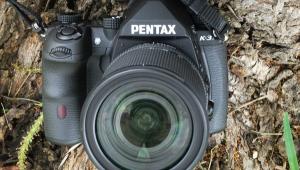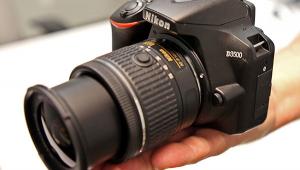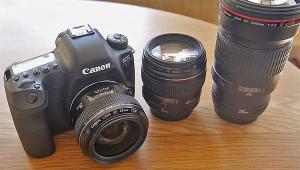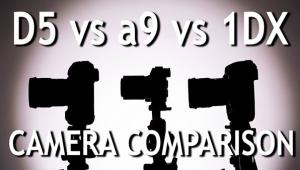Sony’s alpha a55 D-SLT; A New Twist On Design In A 16MP Camera
No, that’s not a typo—the “T” in the acronym refers to the new mirror system in the Sony alpha a55 and stands for “translucent.” This setup, available in this camera and the new alpha a33, uses a fixed mirror system with a “half translucent mirror” that does not flip up during exposure. It allows for a continuous electronic viewfinder (EVF) signal and usage of a standard SLR AF system with an additional AF sensor. The units create yet another camera class, sort of half EVF, single lens (what we call a Compact System Camera, or CSC) and half standard SLR.
 |
|
 |
|
 |
|
|
The new Sony a55, however, looks and behaves very much like a standard SLR. Its interchangeable lens system allows use of all standard Alpha-mount lenses and many Konica Minolta lenses. With a large grip on the right-hand side, the body is shaped like a standard SLR system with the mode dial on the top. Yet, for all the familiarity the camera begs some questions—what possible advantage can a mirror system have that does not move when exposures are made, and at what point should software and image processing be “allowed” to take over the solving of classical photographic problems?
 |
|
|
Fast Framing Rate
As to the first query, a quick answer comes when you inspect the mode dial on the left side of the camera and notice an option that shows a “10” within a continuous exposure symbol. The 10 refers to a 10 frames per second (fps) shooting rate that can be used in “Live View” with the articulating monitor or via the EVF that will follow focus on subjects that move across and through the frame in JPEG, JPEG+Raw, or Raw file format. The lack of mirror slap lets the images flow, if you will, and there’s no finder blackout between frames. This fps rate is contingent on shutter speed settings, of course, and you will not get this in dim lighting at low ISOs. However, this, one of the premier points of this camera, matches the framing rate of specialty D-SLRs in a much more competitively priced body ($749 body only and $849 with the 18-55mm f/3.5-5.6 kit lens).
 |
|
|
I tested this feature at a demonstrationrodeo event and caught moments in the rough-and-tumble action that, for me, would be otherwise unattainable. Is this cheating? Perhaps, but sports photographers rarely poise their fingers above the shutter release awaiting the decisive moment of the play at the plate, and now the rest of us can catch the moment within the moment with relative ease as well.
Sweep Panorama
We’ll get to the second point of inquiry shortly, but first some other points of interest and some test reports from our associated lab at BetterNet. Like the Sony NEX-3 we recently tested (October, 2010, issue), the a55 offers a “sweep” panorama option, which means that the camera will stitch any images you make in one of four directions as you move across the scene with the shutter release pressed. Turn the mode dial to the sweep symbol and then open the Menu to choose “standard” or “wide” (wide for me had the best effect) and then choose the direction in which you will be moving across the scene. (Note: You can also do a “3D” sweep that creates an MPO file for viewing on equipped sets and needed glasses, but lacking both I did not test this.) The results are fun and impressive. I found that when I did this close to a subject in my NEX-3 tests it distorted straight lines, and the same holds here.
 |
|
|
 |
|
|
|
 |
Viewing And Previewing
There are two viewing options—an EVF eyepiece and a fully articulating monitor that looks more like a widescreen flat-panel TV than a standard 3:2 setup. As to the EVF, it really works quite well in low light and even, to an extent, fairly low contrast light outdoors, but I find that EVFs, in general, have a ways to go before they can match the D-SLR eyepiece experience, and the same goes here. The monitor is a better bet overall outdoors, but in contrasty fall light, in which I tested the camera, it often presented challenges as well. I must say that the kit lens supplied with the test camera sent to me didn’t help and showed a considerable tendency toward flare. A lens hood certainly would help and, though I wasn’t supplied one with the kit, it would be the first thing I would buy if I had purchased the kit lens with the body.
The articulating monitor adds to the flexibility of the viewing experience and certainly helps shooting outdoors in bright light. It is “live” in all respects and shows a real-time preview of what you will get in terms of exposure, white balance, responsive focus, and exposure compensation decisions. In fact, “live” really does mean real time in cameras like the a55, and the old photographic idea of previsualization has now been replaced by actual visualization, meaning that you can see what you get and affect results with settings like never before. The trick is to test the system so that you keep monitor and eyepiece viewfinders close to the brightness and contrast of what will be delivered on the memory card. Color management and monitor calibration for cameras, anyone?

















































